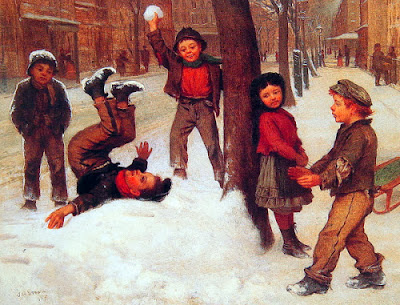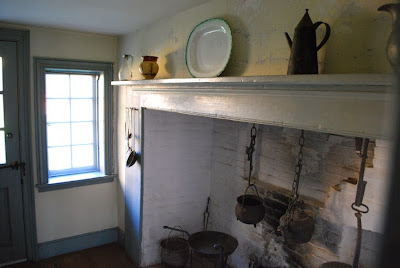Traditions Take Time
Taking Time to Create
Gingerbread-brown is her new name for it – the color of the pullover.
Even after spraying it with water and laying it flat the cables are still
springy. The Lady-of-House made the neck roomy.
Little children have large heads and some don’t like to be stuck in the
dark, inside a tight pullover, even for a moment. “Help,” she could hear her
two-year-old grandson whimper while trying to dress himself. He can be
screech-volume-loud when kicking a ball around, or when his brother
accidentally knocks his blocks over, but in asking for help he manages to lower
his voice to a piteous, impish plea. It works like a charm when there are
females present. Is he conscious of the power of his cuteness?
Years back, at the culmination of a complicated Christmas, the
Lady-of-the-House slouched on the sofa with a long sigh. Gifts were unwrapped
that morning, stomachs were full with Christmas dinner, dishes were washed . .
. and she was relaxing. It was a gray, foggy afternoon. Heavy raindrops had
washed away all the pretty white snow. The woodstove heated the room to a
drowsy-comfort. “Now I can hook my
sheep,” the Lady-of-the-House said. She opened the Harrisville kit, nestled the
round-edged hook in the palm of her hand, and pulled her first piece of wool
into a little loop. “I think I’m going to like this craft,” she prophesized.
It had been the busiest and most exuberant Christmas season ever.
Children’s music rehearsals and recitals, church ministry, parties, shopping,
caroling, cookie baking, hospitality, filled the schedule to the brim. Now a
lull was welcome. She pulled loops all that week, adding extra yarn to the
border of the design, hooking round and round as the canvas would allow.
That tiny rug rested, here and there in closets - for an embarrassing amount of years. Only recently had it occurred to the Lady-of-the-House what to do with it. The notion entered her mind after inspecting her woven-in-American tablecloth which had covered many a holiday dinner table - and dinners in between. “This has seen better days. It’s in a permanent state of stains,” she pronounced. “I can’t give it away. But I can’t throw it away, either. Hmm, I’ll cut away its stain-free borders for fabric and make a pillow with my little sheep in the middle of it,” she recovered brightly. And so she did, this season.
Taking Time to Wander
This year Christmas is uncomplicated. The Lady-of-the-House chose to
forego a tall tree. What a quiet joy to see so many of the family ornaments now
decorating her married daughters’ homes. She also passed along a stack of
Christmas books, saving a portion of for her own basket. She’s been told that
similar reading-baskets bedeck the homes of other self-taught people. This
tradition of enrichment places cheer, interest, and inspiration in easy
reach.
“I remember this,” she exclaimed to her then already teenage children
while sorting through dusty boxes in a ramshackle used-book-shop in Owl’s Head,
Maine, some years back. Thus, Mr. Willowby’s Christmas Tree by Robert Barry published in 1963, was purchased for
old-times-sake. It is a 5-minute story with black and white pen-drawings shaded
only in green. This cheery fairytale has a Goldilocks-and-the-Three-Bears-feel-to-it in its theme of size and reads in rhyme
like the poem, The Night Before Christmas.
Mr. Willowby is well-to-do as evidenced by his house fronted with
stately columns. His ceilings are lofty but not quite high enough to fit the
over-sized Christmas tree. Baxter, the butler, climbs up a ladder and chops off
the top. He presents the piece to the upstairs maid. She sets it on a table in
her attic room but to make it fit she snips off the top and throws it out. The story
reduces down in scale to the size and circumstances of each owner as families
of people and woodland creatures find one piece of Mr. Willowby’s tree smaller
than the next and make it part of their Christmas festivities. The last page is
the cutest.
In the Maine-days, her sister mailed the Lady-of-the-House this stylized
St. Nicholas, obviously sympathizing with life in the back woods. His
cross-country ski poles are tipped with a touch of glitter. The basket on his
back is filled with fruit and gift boxes. Where had the Lady-of-the-House seen
a similar St. Nicholas? “Ah, that’s right,” she thought, “in Efner Tudor Home’s
The Christmas Cat, illustrated by Tasha
Tudor.”
In the story a tall man with a brown beard, dressed like a lumberjack, is cruising through the snow into a clearing in the woods, balancing on a large bobsled that is pulled by two heavy draft horses. The man has an owl on his shoulder. He is a friend to the forest creatures and stops to feed those that have followed the sound of the horses’ bells. Among them is a gray cat shivering in the cold. On Christmas morning the cat appears in the house of two little boys where it curls up on a pillow by the fireside. But who is the generous man? Shh, don’t tell anyone, but he looks a little like another bearded fellow in the story.
In the story a tall man with a brown beard, dressed like a lumberjack, is cruising through the snow into a clearing in the woods, balancing on a large bobsled that is pulled by two heavy draft horses. The man has an owl on his shoulder. He is a friend to the forest creatures and stops to feed those that have followed the sound of the horses’ bells. Among them is a gray cat shivering in the cold. On Christmas morning the cat appears in the house of two little boys where it curls up on a pillow by the fireside. But who is the generous man? Shh, don’t tell anyone, but he looks a little like another bearded fellow in the story.
Tasha Tudor’s watercolor scenes inside and outside the house, transport the nostalgic-prone to simpler times.
Taking Time to Wonder
With the woods bare and white, a few brave Pennsylvania birds can be
spotted now and again by those who are accustomed to peering out of windows at
different times of the day. The Man-of-the-House and his Lady abruptly stopped
their lunch preparations. They were startled by a bird’s song. It sounded so
loud and clear that they momentarily wondered if the bird were inside the
house. His Lady traced the source to the fireplace. “It must be perched on the
chimney,” she said. Two verses were shouted from the housetop. That was all.
But they were beautiful, sweet verses.
Taking Time to Worship
The chimney-top bird affirmed their efforts toward
hospitality and “friendship evangelism” this season, bringing the chorus of a
Christmas song to mind.
Go tell it on the mountain
Over the hills and everywhere
Go tell it on the mountain
That Jesus Christ is born
Wishing you traditions of enrichment,
Karen Andreola




















































